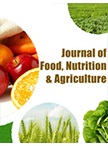Association between feeding patterns and nutritional status of the under five children (6-59 months) in Mtwara Rural District, Tanzania
DOI:
https://doi.org/10.21839/jfna.2019.v2i1.278Keywords:
Cassava, u5 Children, Nutrition Status, Consumption pattern, Individual Dietary Diversity score (IDSS)Abstract
This study was conducted to determine the association between feeding pattern and nutritional status of the under-five children in Mtwara rural district. Nutritional assessment information was collected using three survey tools: food frequency survey, 24 hours diet survey and anthropometric assessment survey. Anthropometric measures of weight and height were used to assess the nutritional status and WHO Anthro Plus was used to compute the anthropometric data to obtain Height for Age Z-score, Weight for Age Z-score and Weight for Height Z-score. The questionnaire was administered to mothers / caregivers of 329 children aged 6 -59 months. The children’s feeding patterns were determined using the 24-hour dietary recall. Dietary diversity score was computed to understand the quality of the diet consumed by the children. Data were analyzed using IBM SPSS Statistics version 20.0 using descriptive statistics. Chi-square was used to determine the association between nutrition status and the independent variables including gender. The findings indicated 41% stunting rate, 18.8% underweight and 7.3% wasting implying poor nutrition. The cassava feeding frequencies varied among households and between and within the two children age groups, (6 – 10 months) and (11-59 months). Overall 87.23% of children (6-59 months) had a feeding frequency of 2 days, 3 days or 6 days in a week. The dietary diversity indicated an average IDDS of 2.5 implying poor diversity of consumed food groups which was similarly far below the target IDDS of 5 established for this study. The results however indicated no significant association (p ≥ 0.05) between cassava consumption pattern and prevalence of stunting, wasting and underweight and also between gender and nutrition status. The high prevalence rate of malnutrition could thus be attributed to a synergistic effect of several factors.
Downloads
References
Caulfield, E.L., and Black, E. R. (2005). Comparative quantification of health risks, zinc deficiency. global and regional burden of disease attributable to selected major Vol.1 1200pp
Dziedzoave, N. T. Abass, A. B., Amoa-Aawua, W. K. A., and Sablah, M. (2006). Quality Management manual for the production of high quality cassava flour. (Adegoke, G.O. and Brimer, L., Eds). International Institute of Tropical Agriculture. Ibadan, Nigeria.
Frozanfar, K. M, Yoshida ,Y, Yamamoto, E, Reyer, A, J, Dalil, S, Rahimzad, D. A., and Hamajima, N. (2016). Acute malnutrition among under-five children in Faryab, Afghanistan: prevalence and causes. Nagoya Journal of Medical Science, 78, 41- 53.
Gegios, A., Amthor, R, Maziya-Dixon, B., Egesi, C, Mallowa, S., Nungo, R., Gichuki, S., Mbanaso, A., and Manary JM (2010). Children consuming cassava as a staple food are at risk for inadequate Iron, Zinc and Vitamin A intake. Plant Foods for Human Nutrition, 65, 64-70.
Gibson, R. S. (2005). Principles of Nutritional Assessment. Oxford University Press, Inc. Newyork.
Hahn, S. K., Reynolds. L., and Egbunike, G. N. (Eds.) (1988). Cassava as livestock feed in Africa. Proceedings of the IITA/ILCA/University of Ibadan. International Institute of Tropical Agriculture Ibaaan, Nigeria.
Kennedy, G., Fanou, N., Seghieri, C., and Brouwer, D. I. (2009). Dietary Diversity as a Measure of the Micronutrient Adequacy of Women’s Diet from Bamako, Mali: Food and Nutrition Technical Assistance II Project (FANTA-2) FHI 360 1825 Connecticut Ave., NW Washington, DC 20009-5721. Retrieved from http://www.fantaproject.org
Magnani, R. (1997). Sampling guide. IMPACT Food Security and Nutrition Monitoring Project, Arlington, Va.
Magoha, H., Kimanya, M., Meulenaer, B. D., Roberfroid, D., Lachat, C., and Kolsteren, P. (2014). Association between aflatoxins M1 exposure through breast milk and growth impairement in infants from Northern Tanzania. World Mycotoxin Journal, 7, 277 - 284
Nungo, A. R, Okoth, W. M., and Mbugu, K. S. (2012). Nutrition status of children under five years in cassava consumning communities in Nambale Busia of Western Kenya. University of Nairobi, Kenya. Food and Nutrition Sciences, 3, 796-801.
Peiris, T. D. R., and Wijesinghe, D. G. N. G. (2011). Nutritional status of under 5 Year-Old Children and its Relationship with Maternal Nutrition Knowledge in Weeraketiya DS division of Sri Lanka. Tropical Agricultural Research, 21, 330–339.
Schoenbaum, M., Tulchinsky, T.H., & Abeid, Y. (1995). Gender differences in nutritional status and feedings patterns among infants in the Gaza Strip. American Journal of Public Health, 85, 965–969.
Shoo, T. A. (2011). Gender division of labour in food production and decision making power and impact on household food security and child nutrition in rural rukwa, Tanzania: Thesis submitted in partial fulfilment of Master of Philosophy degree in International Community Health to University of Oslo, Norway. Retrieved from http://urn.nb.no/URN:NBN:no-31355
Swindale, A., and Bilinsky, P. (2006). Household Dietary Diversity Score (HDDS) for Measurement of Household Food Access: Indicator Guide Version 2. Food and Nutrition Technical Assistance III Project (FANTA) FHI 360 1825 Connecticut Avenue, NW Washington, DC.
Ministry of Health, Community Development, Gender, Elderly and Children (MoHCDGEC) [Tanzania Mainland], Ministry of Health (MoH) [Zanzibar], National Bureau of Statistics (NBS), Office of the Chief Government Statistician (OCGS), and ICF. 2016. Tanzania Demographic and Health Survey and Malaria Indicator Survey (TDHS-MIS) 2015-16. Dar es Salaam, Tanzania, and Rockville, Maryland, USA: MoHCDGEC, MoH, NBS, OCGS, and ICF.
Tanzania Food and Nutrition Centre –TFNC (2014). The United Republic of Tanzania Ministry of Health and Social Welfare Tanzania National Nutrition Survey 2014 Final Report Data collection: 24 September – 21 November 2014. Retrieved from https://www.unicef.org/esaro/Tanzania_National_Nutrition_Survey_2014_Final_Report_18012015.pdf
National Bureau of Statistics (NBS) [Tanzania] and ICF Macro. 2011. Tanzania Demographic and Health Survey 2010. Dar es Salaam, Tanzania: NBS and ICF Macro.
UNICEF (United Nations Children’s Fund) (2013). Improving Child Nutrition: The achievable imperative for global progress. ISBN: 978-92-806-4686-3 eISBN: 978-92-806-4689-4 United Nations Publications Sales No.: E.13.XX.4. www.unicef.org/publications/index.html
WHO. (1997). WHO Global Database on Child Growth and Malnutrition. Programme of Nutrition. Geneva: (WHO DOCUMENT WHO/NUT/97.4)
WHO. (2006). WHO Child growth Standards. Length/height-for-age, weight-for-age, weight-for-length, weight-for-height and body mass index-for-age: methods and development. Department of Nutrition for Health and Development. https://www.who.int/childgrowth/standards/Technical_report.pdf [ISBN 92 4 154693X] (CNLM Classification: WS)
WHO. (2010). World Health Organization/UNICEF/WFP/FAO/FSNAU, Somali Nutrition Strategy 2011-2013: Towards the Millennium Development Goals. Somalia. https://reliefweb.int/sites/reliefweb.int/files/resources/Full_Report_1768.pdf






 .
.